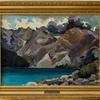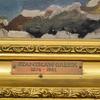Description:
This painting has a certificate confirming its authenticity issued by DESA Dzieła Sztuki i Antyki Sp. z o. o.
A landscape depicting the famous Tatra lake, called Morskie Oko. The static composition shows a part of the lake surrounded by forests with charming rocky streams flowing through them. Monumental, raw granite rocks contrast with the surrounding romantic turquoise-plum water of the lake. This painting is a perfect example of Gałek's fascination with the variability of the Tatra landscape. Gałka's landscapes perfectly reflect the vastness of mountain spaces, the monumentality of rock massifs and the changing weather conditions in the mountains. The painter perfectly captured the transience of the moment and the charm of this place. Looking at this picture, you get the impression that in a moment the clouds swirling over the mountain peaks will change the weather and the view of this place will be unrecognizable. The vastness of the wild landscape, enclosed in this small piece of cardboard, gives the impression of the suppressed power of nature. This enchantment with the arrhythmia of colors, the capriciousness of sounds, and the lability of moments is reflected in this work. Phenomena that were difficult to stop flowed from under his brush, swirling in multicolored spots, changing from pink to blue, from blue to green. The charm of impressions and the sensitivity of the senses make his paintings so amazing, as if they were painted with the self. Through clear color spots and clearly visible brush movements, the artist was able to bring out the most characteristic features of the depicted place. His favorite mountain landscapes included the area around Morskie Oko, which Gałek usually showed, as in this painting, in a fragmentary way, focusing on the view of several mountain peaks and the picturesque bend of the famous lake.
Biography:
Stanisław Gałek (1876 Mokrzyska near Brzesko - 1961 Zakopane).
In the years 1899-1900 he studied at the Academy of Fine Arts in Kraków under the supervision of J. Malczewski and J. Stanisławski. He continued his education at the Kunstgewerbeschule in Munich and at the Ecole Nationale des Beaux-Arts in Paris. After arriving in the country, he lived in Zakopane. He belonged to the Podhale Art Society. He went on numerous artistic journeys, including: to Paris, Italy and Crimea. After 1945, he exhibited in Zakopane, where his anniversary exhibition took place in 1960, and with the 'Zachęta' group in Warsaw. He painted mainly Tatra views; in the interwar period he was considered the best landscape painter of the Tatra Mountains. He also painted portraits.
Detailed biography of the artist
The theme of Stanisław Gałek's work was dominated by his love for the mountains. Fascinated by the Tatra landscapes, the artist decided to connect his life with Zakopane, where he lived, painted, sculpted and worked for the development of Podhale art. Stanisław Gałek was born in Mokrzyska in 1876. He moved to Zakopane at the age of thirteen and began his artistic education there. In 1891, the future painter joined the group of students of the Wood Industry School, where he acquired sculpture skills. Five years later, the artist became Edgar Kováts' assistant and taught young people fascinated by beauty the secrets of drawing. In 1899, Stanisław Gałek began studies at the Academy of Fine Arts in Krakow, where he perfected his craft in the studios of Jan Stanisławski and Jacek Malczewski. He continued his studies in Munich and Paris. His French master was the teacher of many outstanding artists, including Vlastimil Hofman - Jean Léon Gérôme. Stanisław Gałek has been exhibiting his works regularly since 1900. His Tatra landscapes appeared mainly at national exhibitions, but were also known to foreign audiences - especially critics from Vienna, Berlin and Budapest. From 1920, Stanisław Gałek's works were also the attraction of every presentation of the works of Zakopane painters. After graduation, the artist returned to the place from which he drew the most inspiration - Zakopane. From 1912, Gałek combined his painting with a teaching career - then he taught at the Vocational School of the Wood Industry in Kołomyja, and four years later he also educated young Zakopane residents. Stanisław Gałek was active on the board of the "Sztuka Podhalańska" Society, whose main goal was to promote the work of artists through exhibition and purchase of their works. Members of this group also took part in numerous workshops, lectures and similar events aimed at maintaining the art of Podhale at the highest possible level. Active activists for the society also include Stanisław Witkiewicz, Władysław Skoczylas and Tymon Niesiołowski. Stanisław Gałek was also a member of another group involved in popularizing the work of local artists - the Society for the Encouragement of Fine Arts. Stanisław Gałek died in 1961 in Zakopane. He was not only a painter, but also a sculptor and author of kilim designs. However, he gained the greatest recognition as the creator of Zakopane landscapes. They depict mountain ponds and lakes, forests with charming rocky streams, peaks drowning in clouds and meadows shining with white sheep fur. The artist's attention was often drawn to atmospheric phenomena typical of the mountain climate. Fog swirling low over the water surface and mountain slopes, white streaks of mountain wind raging at the foot of snow-capped peaks, or snow cover surrounding the bed of a forest stream - these are just some examples of Gałek's fascination with the variability of the Tatra landscape. He looked for fleeting phenomena that were difficult to capture on canvas not only in mountain landscapes, but also in other, seemingly ordinary places, such as a shepherd's hut. In Stanisław Gałek's paintings, the images of mountain people perfectly synchronize with the specificity of the Tatra landscape, showing the perfect harmony of man and nature. The highlander often depicted by the artist, guarding a flock of sheep against the background of wooden huts and huge mountain ranges visible in the distance, is not only striking, but is also an important element of the Tatra landscape.
Sea eye
Morskie Oku - the pearl of the High Tatras. It is considered the most beautiful of the Tatra lakes. It is located in the Rybi Potok Valley, which, interrupting the moraine closing the lake from the north, flows out of it and flows into the pot. "Białki". The lake fascinated great Poles: it was painted by, among others, Walery Eljasz-Radzikowski, Leon Wyczółkowski, Stanisław Gałek, poets admired its blue waters (Maciej Stęczyński, Wincenty Pol, Adam Asnyk, Kazimierz Przerwa-Tetmajer, Jan Kasprowicz), and also musicians (Zygmunt Noskowski, Mieczysław Karłowicz). In the 19th century, a raft floated on the pond, and the tenant of the shelter welcomed arriving tourists with a mortar shot. Morskie Oko was one of the most famous tourist destinations from the "Chałubiński era". Even then it fascinated Poles, and it remains so to this day. The exceptionally beautiful location of the lake, among the large rock walls surrounding it: Mięguszowieckie Szczyty, Cubryna, Mnich, as well as Żabi Niżni, Żabi Wyżni, Niżni Rysy and Rysy, makes a great impression. The name Morskie Oko is associated with an old legend , which said that the lake had an underground connection with the sea, specifically with the Adriatic Sea. In ancient times it was called Fish Lake, because of the wealth of fish living in it (trout live here).
Parameters:
Dimensions: 47x33 cm
Signature: signed pd ST. KNOB
Support material: Oil on cardboard
Delivery and payment: 
Report a violation




